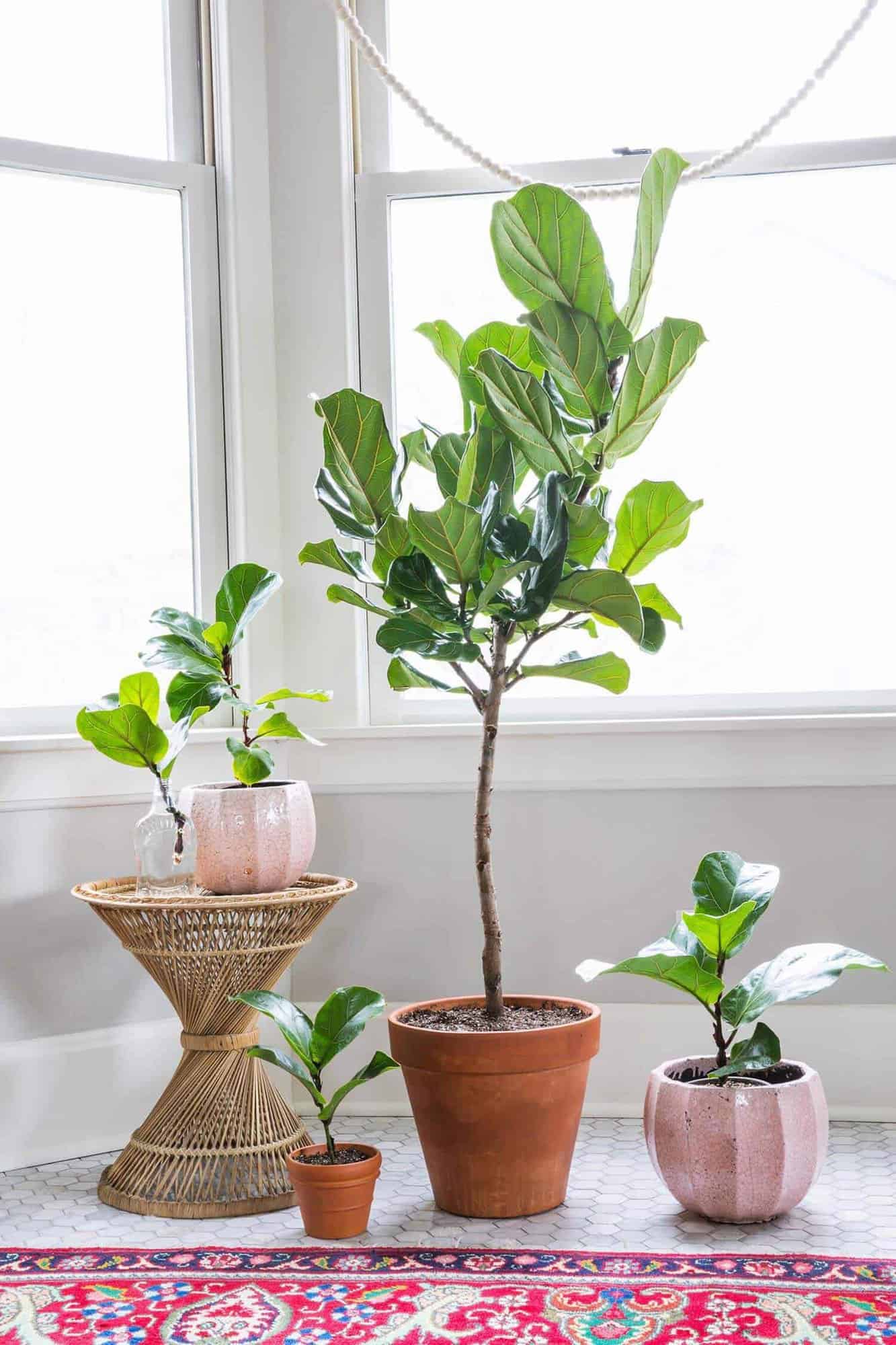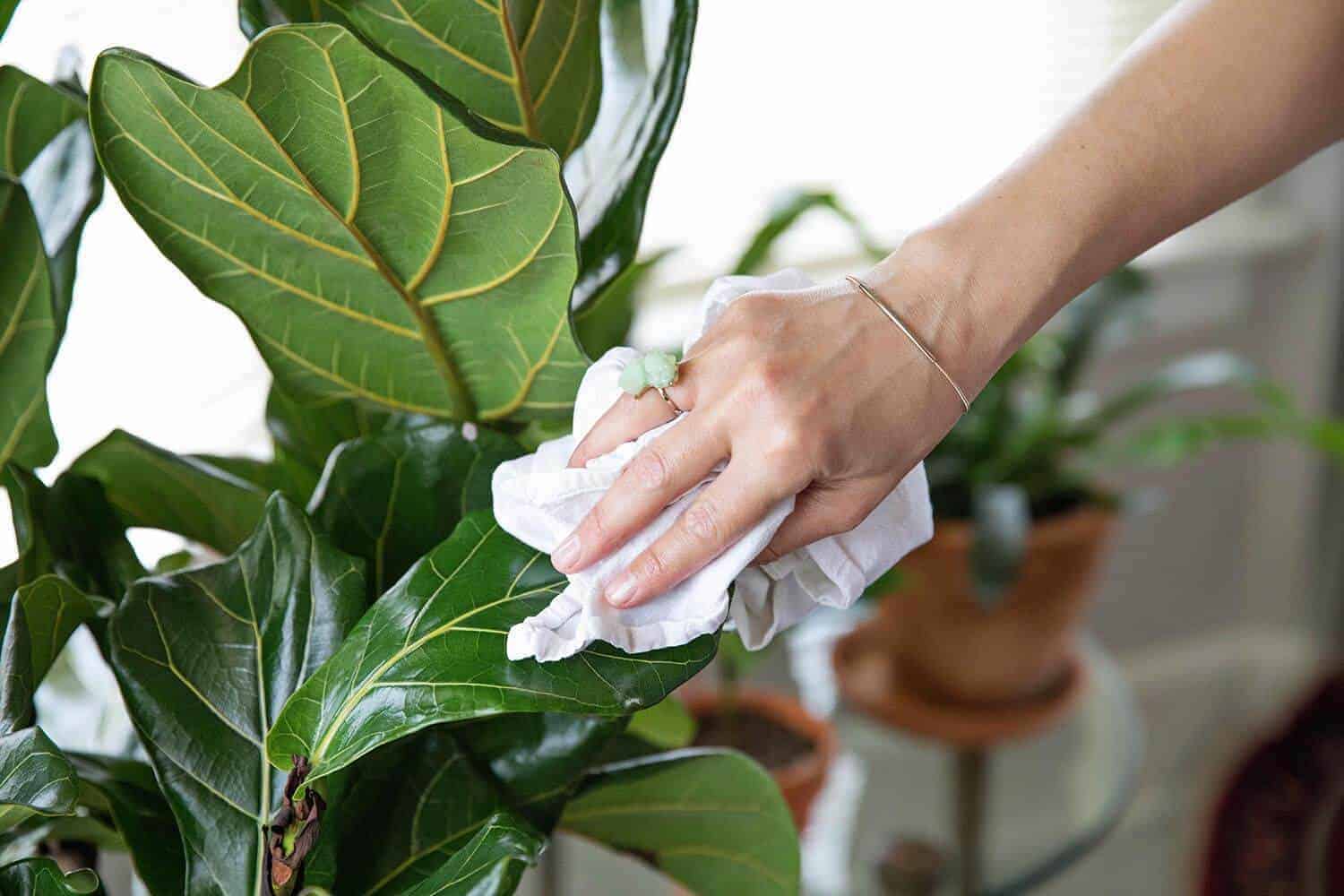I am sure you all have heard of the fiddle leaf fig tree (also known as the ficus lyrata). They have a reputation of being beautiful and also quite difficult to keep alive.
A dying or dead fiddle leaf can leave you a bit heartbroken. Those beautiful leaves start to drop and it’s a pitiful process to witness. If you’ve had one die or you’re just too intimidated to get one, then I hope this post helps.
You bring a gorgeous fiddle leaf home … now what? Most of these trees come in thin/cheap plastic containers when you first purchase them. I like to take my tree out of these suckers as soon as I get home. For pots, I use good ol’ terracotta pots.
My mom taught me to never use plastic pots but use clay or earthenware because it allows the soil to “breathe.” If you get an earthenware pot, make sure it has a hole for drainage. Drainage is vital to a fiddle leaf.
If you don’t have a hole at the bottom of your pot, then the water can pool inside and cause the roots to rot, which can kill your plant. Fiddle leaves don’t like to stay soggy. I will get a pot that is not much bigger than the original pot that it came in. The roots like to be somewhat snug in the pot.
Next, fill the bottom of the pot with some small stones or a drainage disc. These stones aid with drainage and also help the dirt not drain out when you are watering it.
Pour dirt all around the sides, making sure your tree stays straight. Once the sides are filled with dirt, I put my hand down along the sides and make sure the dirt is pushed down all the way.
My favorite potting mix is actually a cactus/palm mix found at local hardware stores. The potting mix has sand in it which helps keep the soil loose and also helps with drainage. I’ve used this mix for years and love it!
As a proud fiddle leaf fig parent, seeing those brand new baby leaves emerge is an exciting milestone! However, you may notice some issues with those delicate new leaves and wonder if your plant is in trouble. Don’t worry! With the proper care, your fiddle leaf fig’s new growth will flourish.
In this article we’ll look at what to expect with new fiddle leaf fig leaves common problems, and how to keep your new growth healthy. Let’s dive in!
What to Expect With New Fiddle Leaf Fig Leaves
Fiddle leaf figs are famous for their large, vibrant green leaves with that signature fiddle shape. The leaves emerge one at a time from the center stalk and unfurl as they mature.
You can expect new leaves to pop up during the growing seasons of spring and summer Your plant is unlikely to actively grow and produce new foliage during its dormant period in fall and winter
New leaves will be small at first, just a tiny furled nub peeking out. Over several weeks, the leaf will lengthen and gradually unfurl, revealing that unmistakable fiddle silhouette.
The new leaf will be lighter green initially but darken as it matures and hardens off. The texture will be more tender and delicate than older leaves. Expect new growth to be about 3-5 inches long.
Don’t be alarmed if you notice some reddish-brown spots on those new leaves. This harmless condition called edema is caused by inconsistent watering. The spots should fade as the leaf matures.
Common Problems With New Fiddle Leaf Fig Leaves
While new growth is a great sign, you may notice some issues with those baby leaves:
-
Holes or tears – New folded leaves can stick together and tear as they unfurl if humidity is too low. Increase humidity for those delicate new leaves.
-
Curled leaves – Low humidity can also cause new leaves to be stunted and curled.
-
Dry and shriveled – Insufficient watering during growth spurts leads to dry, shriveled leaves that fall off easily. Ramp up water when new leaves appear.
-
Small new leaves – Lack of light, water, or fertilizer leads to less resources for small new growth. Assess growing conditions.
-
Leaf drop – Dry air, pests like spider mites, and other stressors can cause new leaves to quickly drop. Address causes.
-
No new growth – If it’s not the dormant season but you see no new leaves, your fiddle leaf fig may be getting insufficient light or suffering from root issues.
While new leaf problems can look troubling, they’re often easily fixed with a few adjustments to care.
How to Keep New Fiddle Leaf Fig Leaves Healthy
Here are tips to ensure your new baby leaves grow up big and strong:
-
Water thoroughly – New growth means a growth spurt! Water more frequently when new leaves emerge. Let soil dry between waterings.
-
Get lighting right – New leaves need bright indirect light but avoid harsh direct sun which can scorch them.
-
Increase humidity – Mist leaves or use a humidifier to prevent new leaves from drying out and getting damaged.
-
Avoid drafts – Protect new growth by keeping fans and vents away which can dry out new leaves.
-
Fertilize regularly – Feed with a balanced houseplant fertilizer to nourish new growth. We recommend specially formulated Fiddle Leaf Fig Plant Food.
-
Monitor for pests – Check new foliage closely for pests like spider mites which love tender new growth.
-
Keep leaves clean – Gently wipe new leaves with a damp cloth to remove dust which can block light and air.
-
Stake if needed – If new leaves are very heavy, add a stake to support emerging growth and prevent breakage.
-
Be patient – It takes weeks to months for new leaves to fully unfurl and toughen. Avoid handling them until mature to prevent damage.
With the right care, your fiddle leaf fig’s delicate new leaves will mature into large, leathery beauties in no time. Just remember to baby those new leaves a bit more than established growth. Then sit back and enjoy your plant’s fresh new look!
Frequently Asked Questions About New Fiddle Leaf Fig Leaves
How often do fiddle leaf figs produce new leaves?
During peak growing season, you can expect new leaf growth every 3-4 weeks typically. Growth slows in fall and winter.
How long does it take for a new fiddle leaf fig leaf to mature?
It takes 4-8 weeks on average for a new leaf to fully unfurl and toughen up. Be patient with new delicate growth!
Why are my new fiddle leaf fig leaves smaller?
Small new leaves often indicate insufficient resources, like water, light or fertilizer. Assess your care regimen.
What causes holes in new fiddle leaf fig leaves?
Holes and tearing result when new furled leaves dry out from low humidity and stick together as they unfurl.
Why do my new leaves keep falling off my fiddle leaf fig?
Causes include dry air, pests on new growth, and insufficient watering during growth periods. Address the specific problem.
How can I prevent new fiddle leaf fig leaves from breaking?
Avoid direct sun, increase humidity, water thoroughly, and don’t handle new delicate leaves until mature to prevent breakage.
Should I remove new fiddle leaf fig leaves with problems?
As long as the main plant is healthy, you can leave new leaves with minor spots or tears to recover on their own. Simply monitor them.
How often should I fertilize for healthy new fiddle leaf fig growth?
Fertilize every 2-4 weeks in the growing season with a balanced houseplant food. We love Fiddle Leaf Fig Plant Food!
Keep Those Fiddle Leaf Fig Leaves Thriving
With the right care, your fiddle leaf fig’s new leaves will unfurl into large, vibrant green beauties. Water thoroughly, increase humidity, fertilize regularly, and avoid direct sun. Address any pest issues promptly. Then enjoy your plant’s fresh new foliage!
For more fiddle leaf fig care tips, check out our Ultimate Guide to Fiddle Leaf Fig Care and Common Fiddle Leaf Fig Problems to diagnose issues.
And don’t forget to grab our specially formulated Fiddle Leaf Fig Plant Food to nourish your plant’s new growth!

Where in my House Should I Put my Fiddle Leaf?
The fiddle leaf is not a huge fan of being moved around. It loves stability and moving it around your house can actually cause the leaves to drop. You can take it to the sink to water it, but moving it for extended periods of time can cause problems.
I never really believed this until I tried it and my fiddle leaf did indeed drop leaves. Another tip is to not have your tree in a drafty area. Near a door (especially during winter) or a vent can really irritate the tree. Find a spot in your home that’s not near a door or vent and has loads of sunshine!

How Much Light do Fiddle Plants Need?
This thing loves the light!! If you get a fiddle leaf, then find a window with ample light. Be sure that it is bright, indirect light. Don’t stick it in a corner away from the sunlight (if you can help it). Its leaves love to drink up the light so keep it in a bright, sunny spot in your home.
Since the tree thrives on bright light, it is very important to keep the leaves clean from dust and dirt. If the leaves get too dusty, they can actually “suffocate” when they don’t have a clean surface. Thanks, photosynthesis!
Every week or so, I wipe the leaves with a wet cloth and get all of the dirt and dust removed. After the leaves are cleaned, I use a leaf shine spray to make them extra glossy.
Since this tree loves drinking up the light, it will eventually start leaning towards the sun. Rotate the tree slightly (some people do every time they water or once a month) and this will help keep the tree straight and balanced.

